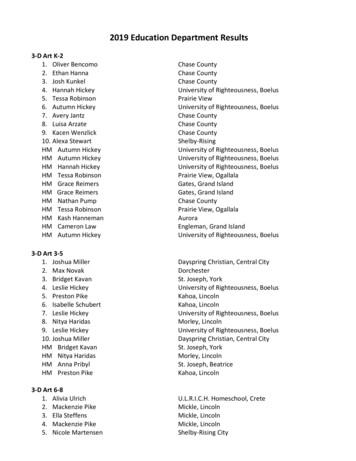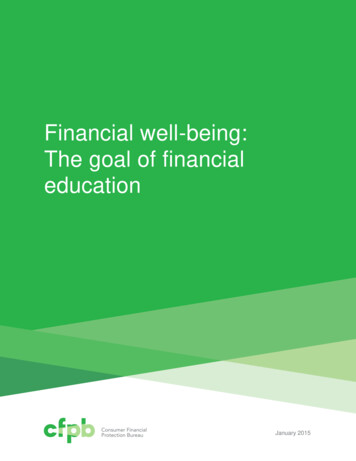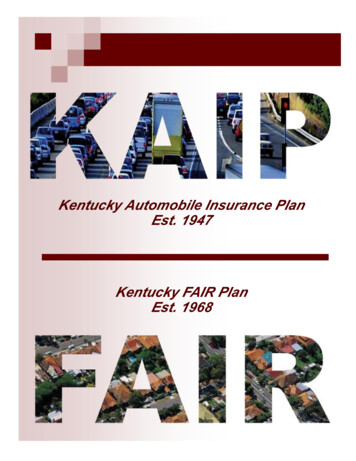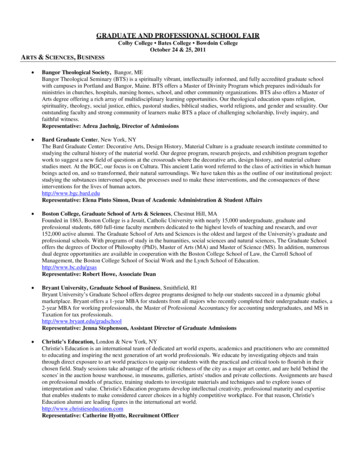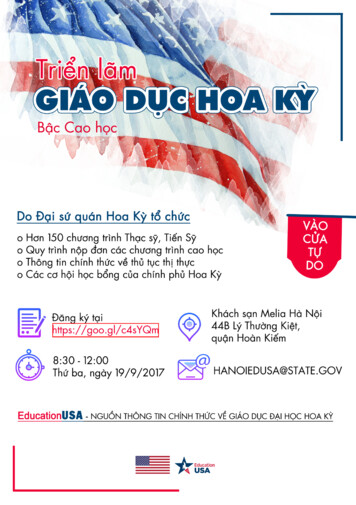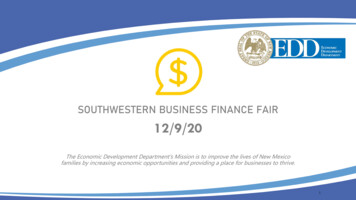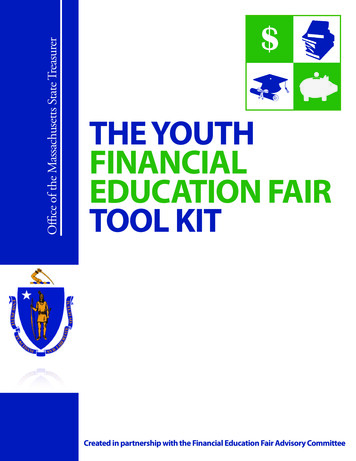
Transcription
Office of the Massachusetts State Treasurer THE YOUTHFINANCIALEDUCATION FAIRTOOL KITCreated in partnership with the Financial Education Fair Advisory Committee
What’s In This Tool Kit?Everything You Need to Run a SuccessfulYouth Financial Education Fair! 10 Step Planning GuideBest Practices & Personal AnecdotesMaster ChecklistFair Mentors & AdvisorsModel Floor PlanSample Booth TopicsSample Booth Price PagesStudent Spending PlanSample Donor LetterSample CurriculaProven Online ReferencesPage 1
ContentsIntroduction . 3History, Acknowledgments, Purpose, & GoalsA 10 Step Fair Planning Guide . 9Development, Execution, & TimelineBest Practices . 15Innovative Ideas, Organizational Structure & Advisory CommitteeSample Materials . 23Fair Coordinator . 23Volunteers . 33Students . 41Teachers . . 53Tool Kit Evaluation . 83Page 2The Youth Financial Education Fair Tool Kit - Office of the Massachusetts State Treasurer
Introduction HistoryAcknowledgementsPurposeGoalsPage 3
HISTORYFinancial Education Fairs have been taking place throughout Massachusetts forover a decade. The Brockton Housing Partnership and HarborOne Bank (FormerlyHarborOne Credit Union) coordinate one of the longest running fairs in theCommonwealth. This group acknowledges Consumer Credit Counseling of SouthernNew England (now Money Management International, Inc.) with introducing themto the fair concept.Since 2009, HarborOne Credit Union has carried the philosophy of sharing the fairmodel and hosts an annual “best practices” meeting for credit unions, banks, schoolsand non-profits. This event imparts valuable tips on how to run a successful fair. Ithas also been instrumental in motivating the formation of fairs in new communitiesacross Massachusetts.The Office of Financial Education at the Massachusetts State Treasury developed thismanual to provide a 10 step guide for developing a fair and to share valuable lessonslearned through trial and error. This guide serves as a link between new faircoordinators and more experienced effective fair coordinators.In June 2011, the Financial Education Fair Advisory Committee, a group of civicminded professionals, convened to carefully review this tool kit, suggested contentand confirm its accuracy. In addition, committee members shared uniqueapproaches, favorite elements of their fairs and offered insight on how to run asuccessful fair.Page 4The Youth Financial Education Fair Tool Kit - Office of the Massachusetts State Treasurer
ACKNOWLEDGEMENTSThe Massachusetts State Treasurer’s Office would like to thank the many individualsand organizations that assist in the production of the Youth Financial Education FairTool Kit, including Treasury Executive Office staff and Jessie Saintcyr, DeputyTreasurer. The tool kit greatly benefits from involvement of the Financial Education FairAdvisory Committee. The committee is instrumental in sharing fair planning expertisefor this tool kit, supporting the expansion of fair development in Massachusetts, andestablishing a core group of mentors to help future fair coordinators.Development By:Leanne Martin FaySheila O’LoughlinLaura RooneyJared WeissAimee BronhardAngelo NubyAnne-Marie BissonBarbara BaranBarbara BassCarole MartynCharity DayCharlene BauerChristine RandallCindy ZomarDan MurphyDeb KumiegaDebra MarkEllen PillsburyGeorge LuotoIngrid AdadeJared WeissJodie GerulaitisJulie BernickKathy MooreyKelly FoxKim BeaulieuKristin RojasLeanne Martin FayLeo MacNeilLinda SaltusMark EisenbergMary Ann ClancyMary Ann ClancyMatthew ParadiseMaureen WilkinsonMelissa LeBelMichael AndelmanMonica CurhanPat WalshPeggy PowellTina PalmerVerge FigueiredoDirector of Financial EducationFinancial Education CoordinatorGraduate Intern, Brandeis UniversityUndergraduate Intern, Boston UniversityDurfee High SchoolMass HousingJeanne D’Arc Credit UnionHolyoke Credit UnionCredit Union League of ConnecticutHarborOne Credit UnionFranklin County Regional HRAMetro Credit UnionMarlborough High SchoolAssabet Valley Regional Technical High SchoolMassachusetts Credit Union Share Insurance CorporationRetired BankerAmeriprise Financial Services, Inc.Foxboro High SchoolHudson School DepartmentLeominster Credit UnionOffice of the Massachusetts State TreasurerCountry BankMoney Management International of MassachusettsCape Cod Five Cents Savings BankAmeriprise Financial Services, Inc.Jeanne D’Arc Credit UnionPawtucket Credit UnionOffice of the Massachusetts State TreasurerHarborOne Credit UnionMass Housing Finance AgencyRetirement SpecialistMassachusetts Credit Union League, Inc.Institute for Savings – NewburyportAmerican Credit Counseling ServicesHarborOne Credit UnionInstitution for Savings - NewburyportFinancial Education EntrepreneurCitizens-Union Savings BankCape Cod Five Cents Savings BankMassachusetts Credit Union LeagueSouth Shore Regional Voc. Tech. High SchoolCambridge Portuguese Credit UnionPage eiredo@cpcu.orgThe Youth Financial Education Fair Tool Kit - Office of the Massachusetts State Treasurer
PURPOSE & GOALWHAT IS A FINANCIAL EDUCATION FAIR?A financial education fair is a fun, interactive simulation of saving, spending, andbudgeting based on career choices and lifestyle decisions. Student participantschoose an occupation and make a variety of financial decisions, ranging from whereto live and how to save for retirement to buying a television or owning a pet. InMassachusetts, these fairs have been given several titles, such as “Credit for Life,”“Reality Fair,” “Reality Check!” and many others.The target audiences that participate in such fairs are high school students. At thisstage many students begin to earn a real income from jobs, so the fair experience hasan immediate application. However, the fair concept can be adapted for other gradelevels or forums such as after school programs or youth camps.PURPOSE OF TOOL KITThe purpose of the youth financial education fair tool kit is to provide an all-purposeguide to help schools, teachers, community organizations, financial institutions orany other entity interested in developing a fair. In time, this guide can bolster theincreasing number of financial education fairs that are administered inMassachusetts communities.GOALS OF A FAIRA youth financial education fair should engage students in the various levels offinancial decision making that they will face in their mid-20s. Every student’sscenario for the purposes of the fair will be based on the path chosen by thatstudent. These paths can include working as young professional with student loans,serving in the military with limited housing costs, or even attending law schooland living “at home” with parents. Students will experience the task of managing abudget while maintaining a balance between future needs and wants.The broader goal of all fairs is to help empower students to be proactive about theirfinancial futures by beginning to develop solid personal finance habits.According to a 2008 study1 conducted by University of Wisconsin-Extension, 97%of student participants in a financial education fair experienced an increase inconfidence of financial management and the majority of these participants plannedto continue to track their spending.1 University of Wisconsin-Extension, Cooperative Extension (2008). Program evaluation report: Youth financial education.Madison, WI: UW-Extension, Program Development and Evaluation. ies.htmlPage 6The Youth Financial Education Fair Tool Kit - Office of the Massachusetts State Treasurer
A well run fair should focus on the following goals:Awareness: An increase in student exposure and understanding of the importanceregarding practical money management habitsInterest: Increased excitement in learning about earning, spending, and savingExperience: Deliver student exposure to experiential learning without the risk offacing any real harmful financial repercussionsSkills: Improved financial decision making and consumer confidenceOUTCOMES OF A FAIRThe most important outcome of a youth financial education fair is that studentsbegin to ascertain the following financial literacy skill-set: Find, evaluate, and apply financial information Set financial goals and plan to achieve them Develop income-earning potential and the ability to save Use financial services effectively Meet financial obligations Build and protect wealthBringing a financial education fair to your community will foster interaction andcollaboration. This event, by design, can provide a unique opportunity for localbusinesses, non-profits, government leaders, colleges, and other volunteers toengage with local teenagers in a purposeful learning experience.Measurable learning goals can be achieved by fairs, but expectations vary greatly,depending on the amount of classroom preparation built into the design. Fairs rangefrom being a required capstone activity in a comprehensive financial educationprogram to a stand alone, one-day event. This guide includes suggestions, surveys,and resources for measuring important outcomes like what a student has learnedfrom participating in a financial education program versus a stand-alone fair. (SeeSample Materials for Fair Coordinator, Page 23)Page 7The Youth Financial Education Fair Tool Kit - Office of the Massachusetts State Treasurer
DON’T REINVENT THE WHEEL!Most Massachusetts-based fairs have been run by a financial institution, a teacher/administrator, or combination of both. The fair is a simulation that requires thestudent participants to imagine they are in their mid-twenties and making dailyfinancial decisions.A standard fair is approximately three hours long. This includes a brief orientation,questions about the program, a couple of hours to visit vendor booths, and awrap-up discussion. Vendor booths are tables with volunteers and are labeledaccording to the expense categories, such as, food, housing, transportation,utilities, luxuries, and more. The students pick up career profiles and spendingplans at the registration booth. Their career selection will determine theireducation requirements and monthly income. Career selection can be presentedas a classroom or guidance activity prior to fair day or chosen upon arrival at thefair. With materials in hand, students begin the interactive component of the fairby visiting every booth. At each booth, they must decide how to use their incomewithout living beyond their means.Every vendor booth has a booth captain who is responsible for organizing boothvolunteers to ensure their station operates efficiently and effectively. Boothvolunteers relay to the students the product or service that is offered at theirgiven booth, often trying to entice students into overspending. (See SampleBooth Descriptions on page 34) Additionally, when students are faltering or needguidance throughout the fair, reminder announcements can encourage them to visitthe Credit Counseling booth for trusted guidance. After visiting all of the vendorbooths, students must visit the Credit Counseling booth one final time. At this time,volunteer credit counselors discuss the good decisions and mistakes that studentsmade along the way. Lastly, a moderator addresses the students and volunteers as agroup to summarize their experiences through discussion.Fair evaluations are provided or required by both student and volunteerparticipants. The evaluation requests for specific examples of how the fair hassharpened the crucial consumer skills and financial literacy of the participants andasks for ways in which the fair could be improved. (See Sample Evaluation Forms,page 40- volunteers, page 49- student)Page 8The Youth Financial Education Fair Tool Kit - Office of the Massachusetts State Treasurer
PARTICIPATING HIGH SCHOOLS MAPMap shows locationsof high schools thatparticipated in a creditfair during the 2012-2013school year.For a detailed list, spx10 STEPS TO PLAN & EXECUTE THE FAIRThe intention of this tool kit is to simplify the fair planning process with a10-step strategy:1. Form a Planning Committee2. Determine Date & Location3. Volunteer Recruitment4. Prepare Students & Teachers5. Fundraising for the Fair6. Plan Outreach Strategy7. Planning Career Profiles & Spending Plans8. Confirm Arrangements9. Promote the Fair10. Survey & Review to Plan for Future Fairs1. FORM A PLANNING COMMITTEEA planning committee should consist of a few key players who will take thelead on coordinating the fair. This committee should be led by one Fair Director.Committee members will be staff or volunteers from the organization(s) that arethe most involved in planning. For example, your planning committee could haverepresentatives from the following groups: Banking Institution School(s) Local Non-profit Organization Parent-Teacher Organization Alumni Association Local BusinessPage 9The Youth Financial Education Fair Tool Kit - Office of the Massachusetts State Treasurer
The planning committee will be taking on the most responsibility in organizing thefair. Members need to be able to make the commitment of attending all meetings,volunteering during the fair and will give the most time. As a result, most planningcommittees are made up of staff from banking institutions and/or schools.Secure commitment of participating school(s):If a non-school entity, such as a bank, credit union, or non-profit organizationis coordinating the fair, a first step should be to secure the support of theadministration and/or departments at your target school(s). This can be donethrough a lead teacher, the guidance department, principal, superintendent and/orschool committee.Using a multimedia presentation when pitching the fair to the administration helpsdepict the educational value, community participation and student engagement.The following videos are a few examples of existing fairs that may be helpful inpresenting the suggested fair: CU4Reality/ The Credit Union Museum:http://www.youtube.com/watch?v 0jshr6FVoJs Credit for Life Fair / Institution For Savings:http://www.youtube.com/watch?v fvynxONrlps Money Strong for Life / Jeanne D’Arc Credit ney-strong-for-life-credit-fair/2. DETERMINE DATE & LOCATIONThe fair director should research potential fair venues and select a location that canaccommodate the anticipated attendees, volunteers and booths while falling withinthe price range agreed upon by the planning committee. Offering the fair on a schoolcampus in a large space such as a gymnasium or field house can significantly reducethe cost of the fair and eliminate travel expenses.Other venues to consider are community college gymnasiums, community centers,or a local hotel ballroom. (See Sample Materials for fair layouts on page 25)Gather your lead planning partners for an initial meeting to determine the followingitems: operational costs/fundraising goals, potential fair dates and location. Presenta projected budget. (See Sample Materials for a sample budget on page 26)Assign booth captains to recruit volunteers and displays for their booths.3. VOLUNTEER RECRUITMENTRecruit members of the public, private business, and non-profit sectors in yourcommunity to get involved in the fair as volunteers, sponsors, or planning partners.Typically the ratio of volunteers to students is 1:3. Commit more volunteers thanneeded at least one month prior to the fair, as oftentimes conflicts come up forvolunteers. Also, allow the volunteers to offer feedback, based on their experiencein specific industries, to help retain the accuracy of the financial choices available toPage 10The Youth Financial Education Fair Tool Kit - Office of the Massachusetts State Treasurer
students. (See Sample Booth Descriptions, on page 34)Also note that when searching for volunteers and/or sponsors, be clear thatbusinesses are not there to sell product(s), but to educate.Booth Captain: This person is responsible for preparing the booth design,recruiting/preparing an adequate number of booth volunteers, and the optionsthey will offer the students during the fair. For example, a financial institution isoften best equipped to provide a captain for a saving/investing or lending booth.A member of the non-profit sector may have the experience to operate the creditcounseling, charity, or health/nutrition booth. Booth captains are also responsiblefor “training” their booth volunteers on their duties during an assigned time fororientation.Additionally, booth captains may choose to go above and beyond by helping orsitting on the planning committee.Booth Volunteers: These are the people that will be trained by the booth captains torun a particular booth (i.e. clothing, housing or luxury).Other Volunteers: Many fairs have other volunteers to help in setting up, breakingdown, clean up or directing students during the fair. You will need some volunteersto deal with these and other miscellaneous tasks.4. PREPARE STUDENTS & TEACHERSStudents: Prior to the fair, it is helpful to provide teachers or guidance counselorswith turn-key lessons to help integrate financial education into the classroom. Theresource section of this tool kit provides sample lessons. Fair coordinators canalso invite guest speakers from the community to present to students about theirarea of expertise. For example, a community banker can talk to the students aboutsaving and borrowing money to reach their long term goals. (See Sample Activities &Resources on page 80)At some schools, classroom preparation for the fair is not always feasible. Inthis case, students should be assembled prior to or at the beginning of the fair toteach them how the spending plan works and how to choose a career profile. It isimportant that students understand what is expected of them as participants of thefair.Teachers: A great way to inform teachers or guidance counselors about the fair andhow they can be instrumental is to present the goals of the fair during a professionaldevelopment day. Ideally, students will be required to participate in the fair, but ifthe fair is optional, like a field trip, teachers can play a role in helping to promotestudent participation by dispersing permission slips, assigning related classroomactivities, or even offering extra credit for attending.Page 11The Youth Financial Education Fair Tool Kit - Office of the Massachusetts State Treasurer
5. FUNDRAISING FOR THE FAIR2Fundraising can be helpful to cover the cost of renting equipment, a venue,marketing, food and any other expenses incurred while planning the fair. The faircoordinator or a volunteer bookkeeper will be responsible for keeping a log of anyexpenses incurred, financial or in-kind donations made, and current or potentialsponsors.Many fairs have reported receiving in-kind donations to cover expenses such as thevenue, f
financial decision making that they will face in their mid-20s. Every student’s scenario for the purposes of the fair will be based on the path chosen by that student. These paths can include working as young professional with student loans,
